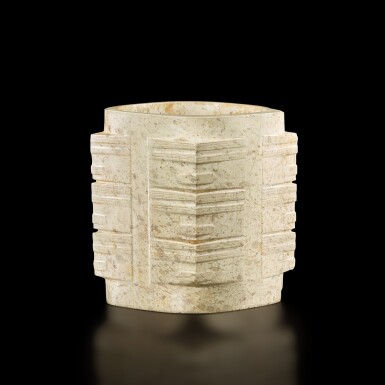Important Chinese Art
Important Chinese Art

Property from an Important Japanese Collection | 日本顯赫收藏
A calcified jade cong, Neolithic period, Liangzhu culture | 新石器時代良渚文化 玉琮
Auction Closed
October 9, 10:57 AM GMT
Estimate
400,000 - 600,000 HKD
Lot Details
Description
Property from an Important Japanese Collection
A calcified jade cong,
Neolithic period, Liangzhu culture
日本顯赫收藏
新石器時代良渚文化 玉琮
7.6 cm
Castle of Antiquities, Hong Kong, 1993.
古城藝術品,香港,1993年
The Liangzhu culture in the Yangtze River Delta, which flourished from the late 4th to the end of the 3rd millennium BC, was one of the most prominent Neolithic Chinese civilizations. Among the large variety of Liangzhu artefacts, cong – tubular jades usually of square section with a central perforation drilled from both ends – stand out as iconic of this culture. They were made for the most prestigious ranks in society. Although the original meanings of cong were lost following the decline of the Liangzhu culture, their form continued to fascinate generations of collectors, connoisseurs, scholars and artisans for centuries. The importance of cong in the history of Chinese art therefore cannot be overstated.
The earliest cong have the form of a circular bangle with a single tier of zoomorphic masks with large round eyes and ferocious fangs. See an example excavated from Zhanglingshan, exhibited in Liangzhu and Ancient China: The 5,000-Year Civilization Demonstrated by Jades, Palace Museum, Beijing, 2019, cat. no. 1; and another from the collection of Duanfang (1861-1911), sold in these rooms, 2nd April 2019, lot 3020. The rectangular form soon took over and the motif became more complex, often featuring a crowned human figure, perhaps a shaman, on top of an animal mask with protruding goggled eyes and wrinkly snout (for details of the duo, see the ‘King of cong’ unearthed from Fanshan, ibid., cat. no. 64). Examples with alternating registers of stylised human faces and animal masks suggest that the motif seen on the present cong represents the face of the shaman and the striated bands probably symbolise the headdress; see ibid., cat. nos 8, 12, 67, 69, 71. Towards the dusk of the Liangzhu civilisation, these elaborate, fine engravings slowly disappeared and simpler designs appeared, while at the same time taller cong with multiple rows of faces, such as the present piece, were made.
A mottled jade two-tier example with a relatively large central perforation, and incised with a row of faces above animal masks, was excavated from Fanshan and included in the aforementioned catalogue, cat. no. 10. Comparable multi-tier cong are also preserved in major museums and private collections, such as a mottled jade three-tier example in the Freer Gallery of Art, Washington DC, accession no. F1917.65a-d.
